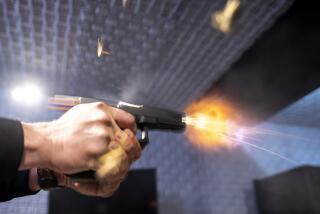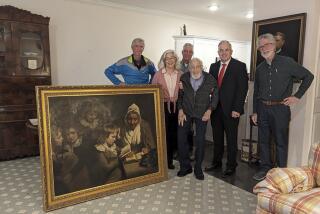Near Newtown, U.S. gun ethos on display at museum
Connecticut’s familiarity with weapons manufactured for personal use long predates the horrifying recent mass killing in Newtown, one of the worst outbursts of gun violence in American history. About 50 miles northeast of the village, Hartford’s Wadsworth Atheneum Museum of Art records the historical culture of guns in several acute and significant ways.
The venerable Wadsworth is the nation’s first public art museum, established in 1842, while America’s most celebrated handgun maker, Colt’s Manufacturing Co., was founded in Hartford soon after. Samuel Colt transformed the industry with his invention of a gun that could fire numerous shots without reloading — a legacy that also had an influence on the museum. Art that resonates with America’s gun culture is embedded in its often exceptional collection.
There’s the Elizabeth Hart Jarvis Colt Collection, donated by Sam’s widow in 1905. It includes the lavish furnishings of Armsmear, the family’s vast Italianate mansion south of downtown. Selections from Colt’s personal collection of firearms and armor are likewise displayed in the museum’s decorative arts galleries.
PHOTOS: Mourning after the massacre
But the galleries also house two remarkable paintings, which together tell a tale of how guns have been woven deep into the national ethos. One is William Michael Harnett’s eccentric 1890 masterpiece, “The Faithful Colt,” a virtual portrait of a handgun seen in illusionistic close-up hanging on a nail against a green wooden door. The other is an 1857 landscape called “The Charter Oak,” the only noteworthy canvas by the little-known Charles De Wolf Brownell, a local Hartford lawyer who quit and turned to art.
The weapon Harnett chose to paint is an antique, not an up-to-the-minute 1890 design — a choice that endowed a simple still life with the gravity of a history painting. Originally titled “An Old-Fashioned Colt,” it was renamed either by Harnett or an art dealer bent on establishing his reputation. Invoking trust, “The Faithful Colt” adds moral heft to a hyper-real image that’s like a snapshot from a loving family album of revered ancestors.
Harnett used the peculiar door motif for many still life paintings, variously hanging a plucked chicken, a horseshoe, a violin or a letter rack on it. In a series titled “After the Hunt” he got fancy, piling on clusters of dead birds, shot bunnies, hats, horns, rifles and other objects. In all of them the flat door merges with the plane of the canvas, making the objects on it pop out.
But the lean gun portrait — the first Harnett painting to enter a museum collection, more than four decades after the then-forgotten artist’s death — is the strangest. A. Everett “Chick” Austin Jr., innovative director of the Wadsworth, bought the picture in 1935.
The gun hangs above a tattered news clipping stuck to the board, its urgent message virtually illegible. Austin responded to the painting’s spectral, even uncanny quality, which he believed was an ancestor to the hallucinatory new Surrealist images then proliferating in Modern art. (Austin organized the first American museum show of Surrealist art.) Three years later Alfred Barr, director of the Museum of Modern Art in nearby New York, included the Hartford Harnett among 228 American paintings he sent to the Jeu de Paume in Paris, birthplace of the Surrealist movement.
For the tragedy in Newtown, however, probably the most cogent painting in the Wadsworth’s collection is “The Charter Oak.” It resonates with a powerful American mythology, one that unites liberty with guns.
Brownell painted it the same year Sam and Elizabeth Colt moved into Armsmear, in the period when the U.S. War Department began to purchase Colt weapons. The Army joined a thriving private market for the guns, well-established among townspeople and rural farmers.
“The Charter Oak” was painted while the gathering clouds of civil war were growing dark. It depicts a mighty, ancient tree whose full leaf and gnarled limbs are a testament to powerful endurance.
The grand oak stands next to a fence on a cleared hillside, evidence of civilization in harmony with nature. Against the rise of the sloping hill, limbs reach across and down the canvas toward a peaceful city in the distance — an enclave marked by a small but distinctive blue onion-dome rising just above the horizon.
It’s the famous dome of Colt’s Manufacturing Co., topped with a cast-bronze rampant horse.
“According to legend,” says the museum’s description of the charter oak myth, “in 1687 Joseph Wadsworth (ancestor of Atheneum founder Daniel Wadsworth) hid the Connecticut charter guaranteeing the colony’s right to self-government in the hollow of a great oak, thereby saving it from seizure by the British governor of New England.” The tree became a symbol of American independence, an image today stamped on the back of the Connecticut state quarter.
The fabled oak itself was toppled in a violent storm 170 years after the legendary event, prompting Brownell’s memorializing painting. The work’s elaborate picture frame, festooned with classical shields sprouting oak leaves, is even said to have been carved from the felled tree’s wood.
Brownell’s graceful artwork is a mythic image. Juxtaposing Colt with civilized order, pairing the new handgun manufacturer with the state’s founding legend, this strange and fetishistic object offers a pastoral narrative of armed preparedness against intrusive government authority.
Partly it speaks to a sentiment voiced often during the last week, in the push-back against rising demands for congressional action on gun-safety laws. An armed populace is essential, so the claim goes, because it stands between government tyranny and freedom.
The idea is sheerest fantasy. Never once since the nation’s founding have citizens expressed a need to take up arms against their government, either state or federal. Nor is there any evidence of government restraint in response to its awareness of an armed populace.
Like Harnett’s spectral gun, however, Brownell’s fanciful painting shows just how deep in our national mythology those roots run. As the debate over what to do about the proliferation of weapons heats up, other reasons can be cited for the private ownership of guns. Yet the fairy tale about keeping America free lives on.
christopher.knight@latimes.com
MORE
INTERACTIVE: Christopher Hawthorne’s On the Boulevards
VOTE: What’s the best version of ‘O Holy Night’?
PHOTOS: Arts and culture in pictures
More to Read
The biggest entertainment stories
Get our big stories about Hollywood, film, television, music, arts, culture and more right in your inbox as soon as they publish.
You may occasionally receive promotional content from the Los Angeles Times.







